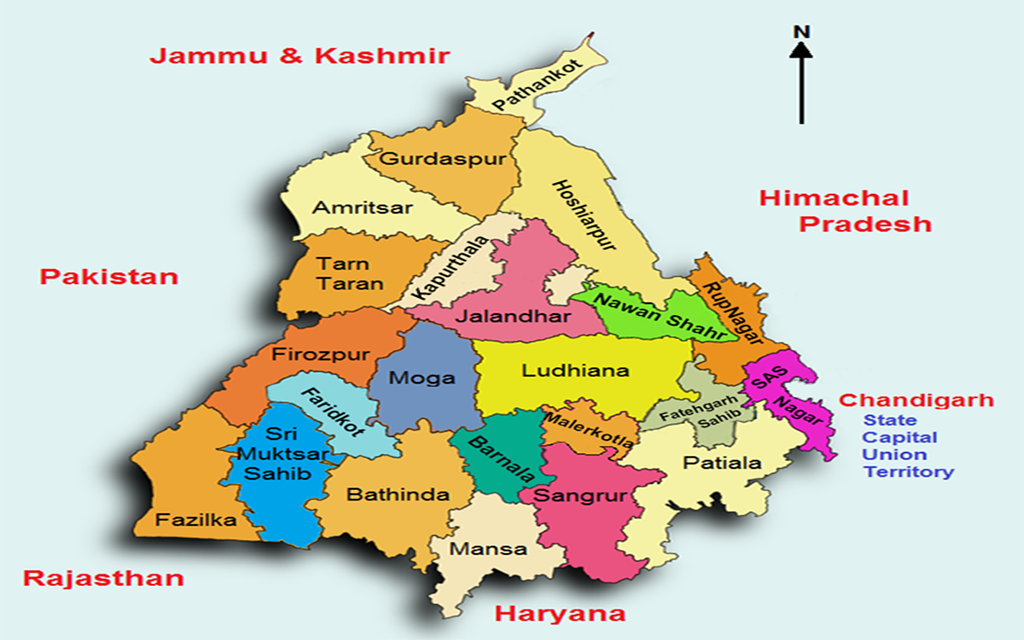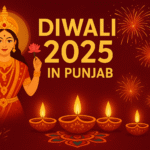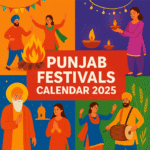Lok Sabha is the lower house of the Parliament of India, where the representatives of the people are elected by direct voting. Lok Sabha seats are allocated to each state and union territory based on their population, as per the provisions of the Constitution of India. The total number of Lok Sabha seats in India is 543, out of which 13 are reserved for Punjab.
Punjab is a state in northern India, known for its rich culture, history, and agriculture. Punjab has a population of about 27.7 million, according to the 2011 census, and covers an area of about 50,362 square kilometers. Punjab shares its borders with Jammu and Kashmir, Himachal Pradesh, Haryana, Rajasthan, and the Pakistani province of Punjab.
Punjab has been a politically significant state in India, as it has witnessed many movements and conflicts, such as the Partition of India, the Green Revolution, the Khalistan movement, and the 1984 anti-Sikh riots. Punjab has also produced many prominent leaders, such as Bhagat Singh, Lala Lajpat Rai, Udham Singh, and Parkash Singh Badal.
In this article, we will provide you with a comprehensive guide on the Lok Sabha seats in Punjab, including the names of the constituencies, the current MPs, the parties they belong to, and the results of the 2019 general elections. We will also discuss some of the key issues and challenges that Punjab faces, and how they affect the political scenario of the state.
How Many Lok Sabha Seats are There in Punjab?
As mentioned earlier, Punjab has 13 Lok Sabha seats, out of which four are reserved for the Scheduled Castes (SC) candidates. The SC reserved seats are Faridkot, Fatehgarh Sahib, Hoshiarpur, and Jalandhar. The remaining nine seats are general seats, which are open to all candidates. The names of the 13 Lok Sabha constituencies in Punjab are:
- Amritsar
- Anandpur Sahib
- Bhatinda
- Faridkot (SC)
- Fatehgarh Sahib (SC)
- Firozpur
- Gurdaspur
- Hoshiarpur (SC)
- Jalandhar (SC)
- Khadoor Sahib
- Ludhiana
- Patiala
- Sangrur
The map below shows the location and boundaries of the 13 Lok Sabha constituencies in Punjab.
Who are the Current MPs of Punjab?
The current MPs of Punjab were elected in the 2019 general elections, which were held in seven phases from April 11 to May 19, 2019. The results were declared on May 23, 2019. The voter turnout in Punjab was 65.96%, which was higher than the national average of 67.11%.
The table below shows the names of the current MPs of Punjab, the parties they belong to, and the votes they received in the 2019 general elections.
| Constituency | MP | Party | Votes |
| Amritsar | Gurjeet Singh Aujla | Indian National Congress (INC) | 4,55,199 |
| Anandpur Sahib | Manish Tewari | INC | 4,00,942 |
| Bhatinda | Harsimrat Kaur Badal | Shiromani Akali Dal (SAD) | 4,92,824 |
| Faridkot (SC) | Mohammad Sadique | INC | 4,21,273 |
| Fatehgarh Sahib (SC) | Amar Singh | INC | 4,14,201 |
| Firozpur | Sukhbir Singh Badal | SAD | 7,01,626 |
| Gurdaspur | Sunny Deol | Bharatiya Janata Party (BJP) | 5,58,719 |
| Hoshiarpur (SC) | Som Parkash | BJP | 4,66,281 |
| Jalandhar (SC) | Santokh Singh Chaudhary | INC | 3,92,533 |
| Khadoor Sahib | Jasbir Singh Gill | INC | 4,99,404 |
| Ludhiana | Ravneet Singh Bittu | INC | 3,63,877 |
| Patiala | Preneet Kaur | INC | 5,32,027 |
| Sangrur | Bhagwant Mann | Aam Aadmi Party (AAP) | 4,13,561 |
The table shows that out of the 13 Lok Sabha seats in Punjab, eight were won by the INC, four by the SAD-BJP alliance, and one by the AAP. The INC emerged as the single largest party in Punjab, with a vote share of 40.31%, followed by the SAD-BJP alliance with 35.64%, and the AAP with 7.38%. The other parties and candidates, such as the Punjab Democratic Alliance (PDA), the Bahujan Samaj Party (BSP), and the Lok Insaaf Party (LIP), could not win any seat, but managed to get some votes.
The 2019 general elections in Punjab were marked by several factors, such as the popularity of the incumbent Chief Minister Captain Amarinder Singh, the anti-incumbency against the Modi government at the center, the farmer protests against the agrarian crisis, the drug menace, the sacrilege issue, and the role of the NRIs. The INC was able to capitalize on these issues and project itself as the party that can protect the interests of Punjab and its people. The SAD-BJP alliance, on the other hand, faced a backlash from the voters, especially the Sikhs, for its perceived failure to address the concerns of the state and the community. The AAP, which had won four seats in the 2014 general elections, lost its ground due to the internal rifts and the lack of a credible leadership.
What are the Key Issues and Challenges that Punjab Faces?
Punjab, despite being one of the most prosperous and developed states in India, faces many issues and challenges that affect its economy, society, and politics. Some of the major issues and challenges that Punjab faces are:
- Agrarian crisis: Punjab is known as the breadbasket of India, as it contributes to about 18% of the country’s wheat production and 11% of the rice production. However, the agricultural sector in Punjab is facing a severe crisis, due to the declining productivity, rising input costs, shrinking land holdings, falling water table, environmental degradation, and lack of diversification. The farmers in Punjab are also unhappy with the three farm laws passed by the central government in 2020, which they fear will undermine their livelihood and autonomy. The farmers have been protesting against the laws for months, demanding their repeal and a legal guarantee of the minimum support price (MSP) for their crops.
- Drug menace: Punjab is also grappling with the problem of drug abuse, especially among the youth. According to a study by the All India Institute of Medical Sciences (AIIMS) in 2019, about 27.6 lakh people in Punjab are addicted to drugs, which is about 7.9% of the state’s population. The most commonly used drugs are opioids, such as heroin, opium, and synthetic drugs, such as tramadol, buprenorphine, and codeine. The drug menace has led to various social and health issues, such as crime, violence, HIV/AIDS, hepatitis, mental disorders, and suicides. The state government has taken some steps to curb the drug problem, such as launching a helpline, setting up de-addiction centers, and cracking down on the drug peddlers and suppliers, but the challenge remains huge and complex.
- Unemployment: Punjab also faces a high rate of unemployment, especially among the educated and skilled youth. According to the Centre for Monitoring Indian Economy (CMIE), the unemployment rate in Punjab was 16.1% in December 2020, which was higher than the national average of 9.1%. The lack of job opportunities in the state has forced many young people to migrate to other states or countries in search of better prospects. The state government has announced some schemes and initiatives to generate employment and entrepreneurship, such as the Ghar Ghar Rozgar Yojana, the Punjab Skill Development Mission, and the Startup Punjab Hub, but the results are yet to be seen.
- Religious and communal harmony: Punjab is also a state that has a history of religious and communal conflicts, such as the Khalistan movement, the 1984 anti-Sikh riots, the Dera Sacha Sauda controversy, and the Bargari sacrilege case. These incidents have left a deep scar on the psyche of the people and have created a sense of mistrust and alienation among the different communities. The state government and the civil society have been trying to promote peace and harmony among the people, by ensuring justice, dialogue, and reconciliation, but the challenge remains to heal the wounds and prevent any further violence.
These are some of the key issues and challenges that Punjab faces, and they have a significant impact on the political scenario of the state. The people of Punjab expect their representatives, both at thestate and the center, to address these issues and challenges effectively and efficiently. The people also want their representatives to uphold the values of democracy, secularism, and federalism, and to safeguard the rights and interests of Punjab and its people.
What is the Future of Punjab Politics?
The future of Punjab politics is uncertain and unpredictable, as the state is heading towards the next assembly elections, which are due in early 2022. The current political scenario in Punjab is marked by several factors, such as:
- The performance of the Congress government: The Congress government, led by Captain Amarinder Singh, has been in power since 2017, after defeating the SAD-BJP alliance, which had ruled the state for 10 years. The Congress government has claimed to have fulfilled most of its poll promises, such as waiving off the farm loans, providing jobs, cracking down on the drug mafia, and ensuring justice for the sacrilege victims. However, the government has also faced criticism and allegations of corruption, nepotism, inefficiency, and failure to deliver on some of the key issues, such as the farm laws, the power crisis, the sand mining scam, and the Covid-19 management. The government has also witnessed some internal dissent and factionalism, especially from the former cabinet minister Navjot Singh Sidhu, who has openly challenged the leadership of Captain Amarinder Singh.
- The revival of the SAD-BJP alliance: The SAD-BJP alliance, which had suffered a humiliating defeat in the 2017 assembly elections and the 2019 general elections, has been trying to regain its lost ground and credibility in Punjab. The alliance had broken up in 2020 over the issue of the farm laws, as the SAD had opposed the laws and quit the NDA government at the center. However, the alliance has recently announced its reunion, after the BJP agreed to accommodate the SAD’s demands on the farm laws, such as giving a written assurance on the MSP and the procurement system. The alliance has also tried to woo the voters by promising to implement a pro-people agenda, such as providing free electricity, water, and education, and by highlighting the achievements of the Modi government at the center, such as the Covid-19 vaccination drive, the welfare schemes, and the national security.
- The emergence of the AAP as a third alternative: The AAP, which had made a remarkable debut in the 2014 general elections by winning four Lok Sabha seats in Punjab, has been trying to emerge as a third alternative to the Congress and the SAD-BJP alliance. The AAP has claimed to be the voice of the common people, especially the farmers, the youth, the Dalits, and the urban poor. The AAP has also tried to project itself as a clean and honest party, free from corruption, dynastic politics, and religious bias. The AAP has announced that it will contest the 2022 assembly elections on its own, without any alliance or coalition. The AAP has also declared that it will announce its chief ministerial candidate soon, unlike the previous elections, when it had faced the criticism of being a Delhi-centric party, without a local face or leadership.
- The entry of new players and alliances: The Punjab political landscape has also witnessed the entry of some new players and alliances, who are trying to make their mark and influence the outcome of the elections. Some of these are:
- The Punjab Democratic Alliance (PDA): The PDA is a coalition of six regional and smaller parties, such as the Bahujan Samaj Party (BSP), the Punjab Ekta Party (PEP), the Lok Insaaf Party (LIP), the Revolutionary Marxist Party of India (RMPI), the Punjab Manch, and the CPI. The PDA was formed in 2019, with the aim of providing a viable alternative to the mainstream parties, and to raise the issues of the marginalized and oppressed sections of the society, such as the Dalits, the farmers, the workers, and the minorities. The PDA has announced that it will contest the 2022 assembly elections under the leadership of Sukhpal Singh Khaira, the president of the PEP and a former AAP leader.
- The Shiromani Akali Dal (Democratic) (SAD-D): The SAD-D is a breakaway faction of the SAD, led by Sukhdev Singh Dhindsa, a veteran leader and a Rajya Sabha MP. The SAD-D was formed in 2020, after Dhindsa and his son Parminder Singh Dhindsa rebelled against the leadership of Parkash Singh Badal and Sukhbir Singh Badal, and accused them of corruption, nepotism, and mismanagement of the party and the state. The SAD-D has claimed to be the true representative of the Sikh community and the Panthic agenda, and has vowed to restore the glory and dignity of the SAD, which it alleges has been tarnished by the Badals. The SAD-D has also expressed its willingness to join hands with other like-minded parties and groups, such as the AAP, the PDA, and the farmers’ unions, to form a broad anti-Badal and anti-Congress front.
- The Navjot Singh Sidhu factor: Navjot Singh Sidhu, the former cricketer and TV personality, who is currently a Congress leader and an MLA from Amritsar East, has been a prominent and controversial figure in Punjab politics. Sidhu, who had joined the Congress in 2017, after quitting the BJP, has been vocal and vocal about his ambitions and aspirations, and has often clashed with the Chief Minister Captain Amarinder Singh over various issues, such as the power crisis, the sand mining scam, the sacrilege case, and the cabinet reshuffle. Sidhu has also been seen as a potential chief ministerial candidate by some of his supporters and admirers, who have been lobbying for his elevation within the party. Sidhu’s role and future in the Congress and in Punjab politics remains uncertain and unpredictable, as he has not ruled out the possibility of joining or forming another party or alliance, if his demands and expectations are not met by the Congress leadership.
These are some of the factors that will shape and influence the future of Punjab politics, as the state gears up for the 2022 assembly elections. The elections will be a crucial test for the incumbent Congress government, the resurgent SAD-BJP alliance, the aspiring AAP, and the emerging new players and alliances. The elections will also be a reflection of the aspirations and expectations of the people of Punjab, who will decide the fate and direction of their state and its politics.
Conclusion
In this article, we have provided you with a complete guide on the Lok Sabha seats in Punjab, including the names of the constituencies, the current MPs, the parties they belong to, and the results of the 2019 general elections. We have also discussed some of the key issues and challenges that Punjab faces, and how they affect the political scenario of the state. We have also given you a glimpse of the future of Punjab politics, and the factors that will determine the outcome of the 2022 assembly elections.
We hope you have found this article informative and interesting. If you have any questions or feedback, please feel free to leave a comment below. Thank you for reading PRPunjab, your trusted source of news and analysis. Stay tuned for more updates and insights on Punjab and India.
FAQ
How many Lok Sabha seats are there in Punjab?
There are 13 Lok Sabha seats in Punjab, out of which four are reserved for the Scheduled Castes (SC) candidates.
Which party won the most Lok Sabha seats in Punjab in the 2019 general elections?
The Indian National Congress (INC) won the most Lok Sabha seats in Punjab in the 2019 general elections, with eight seats out of 13.
What are some of the key issues and challenges that Punjab faces?
Some of the key issues and challenges that Punjab faces are the agrarian crisis, the drug menace, the unemployment, and the religious and communal harmony.
When are the next assembly elections in Punjab due?
The next assembly elections in Punjab are due in early 2022.







